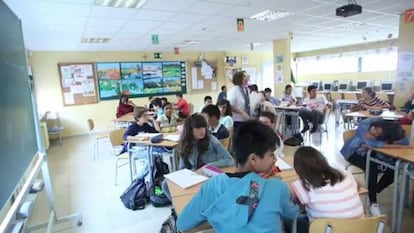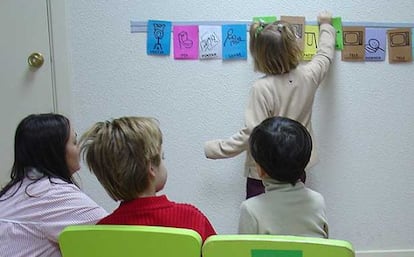Why Iván has to travel 57 kilometers just to get to school
Parents of kids with disabilities are torn between special education and regular school


They have read everything there is to read about their children’s disorders. They have learned to use the jargon – ACNEES, TEA, ATE, PT and more – and created almost as many associations as there are competing theories about the best way of addressing diversity.
But all the parents of children with disabilities share the same fear: what will happen to their little ones when their elders are no longer there?
Their future greatly depends on what they learn at school: how self-sufficient their teachers help them become, their level of integration in the class, and whether they attend a special education school or a regular center.
I was working for half a year, but they kicked me out in the end. No boss can put up with this”
Vanessa Mesa, mother of two boys with Fragile X Syndrome
In the school year 2012-2013 (the last with available Education Ministry figures), there were 420,686 children with special education needs in Spain. Of these, 167,903 had disabilities.
National legislation establishes that authorities at all levels must provide “the necessary means for them to attain their maximum personal, intellectual, social and emotional development” under the principles of “normalization and inclusion.” Under these laws, children with disabilities will only be enrolled in special education schools “when their needs cannot be attended to” at regular schools.
Some parents are faced with the dilemma of whether to take their child to an ordinary center with more possibilities for socializing, or to a special one with professionals who have been trained in special education.
But others didn’t even get that choice.
Iván is a beautiful blond boy with large blue eyes. He is six years old, and until two years ago he and his sister were going to the same school, El Olivos, which is just 500 meters from their home in Cabanillas del Campo (Guadalajara).
His new school, Araya, is 57 kilometers away, in Madrid. His father, Eduardo Ramiro, takes him there every day. On a good day, the commute takes 40 minutes; on a rainy day with traffic jams, it can be two hours.
Eduardo Ramiro and Isabel Maté would have liked for their boy to stay in his old school, but education cuts have forced them to find a center with the kind of support that he needs. Iván is autistic.
A recent report on the diversity and quality of education drafted by the labor union Comisiones Obreras using 2009-2012 data shows that budget cuts have particularly affected special education students, as specialized teachers have been let go.
During the period in question, primary and secondary teacher numbers fell a combined 10.4 percent, while students per classroom rose six percent. This means greater difficulty seeing to the needs of special education children.

The union also reported that the Education Ministry has slashed investment in special education programs by 51 percent. The Madrid region is spending 29.3 percent less, Extremadura 28.8 percent less, and Catalonia 19.2 percent less.
Isabel Maté, just like the parents of most children with disabilities who talked to EL PAÍS for this story, insists that the problem with the regular school was not the teachers, just the lack of resources.
“His teacher asked us how she might help Iván, then she consulted with an association and paid out of her own pocket for a course on how to deal with autistic children,” she explains. “We will be eternally grateful to her for that, and whenever Iván has a Madrid holiday, he always pays a visit to his old teachers in Cabanillas.”
Maté says that the reason they took him out of there was that they were afraid the constant budget cuts meant that Iván would not get the help he needs.
“They doubled the number of students per classroom, from 14 to 28,” says Maté. “The first year Iván had five support sessions a week; the second year he had two and a half, and the speech therapist was shared by three schools... Now, in the school for autistic children, he is progressing much faster.”
Maté and Ramiro are not dismissing the advantages of a regular school. “It’s a way for other people to see that individuals with disabilities do exist, and if in future, some of those children grow up to be entrepreneurs, they may hire someone with a disability because they have first-hand knowledge about how these other kids can do many things as well. It’s an enriching experience for the students.”
But the price of integration was becoming too high. “The reality is what it is: there are not enough resources to go around.”
The idea of integration is perfect, and many people will tell you that special education centers are like ghettos. But reality is what it is, and society is not prepared”
Miguel Gallardo, cartoonist and father of an autistic child
Other parents complain that authorities are sending their kids directly to special education centers before providing the necessary tools to keep them in ordinary classrooms.
“Gerard has severe autism. We wanted him to attend the same school as his sister, but they forced us to go to another one 10 kilometers away because they said they didn’t have the means to deal with him there. Many parents have gone through the same thing,” says Teresa Miralles, who lives in Barcelona.
“My son has a maturity delay and eyesight problems, and they wanted to send him to a special education center 70 kilometers away when he was just seven years old,” says Mar Álvarez, who lives in the village of Cistierna, in León province. “They suggest that if you don’t, you’re being a bad mother, that the other kids are going to laugh at him. But that’s only if this attitude is encouraged: school exclusion is preparation for future social exclusion.”
Álvarez is a member of Solcom, an association that provides advice to the parents of children with special education needs and who have decided to take legal action against the State in order to keep their kids in ordinary schools.
“We have 189 cases, one of which is in Strasbourg right now. It’s an autistic child from Palencia who has been out of school for seven years because he is being forced to go to a special education school,” says Álvarez.

In February 2014, the Constitutional Court ruled against the family and in favor of the regional government of Castilla y León, whose specialists were recommending a special education center because the child needs “individualized attention.”
The court felt that even though the law contemplates the right to go to regular school, the government can send children with special needs to other centers if the support required is unreasonable, as the court considered it to be the case here. Two judges entered a decision in favor of the family.
“It should not be a parent’s job to be suing the authorities or acting as a lobby... but families are being forced to give up their convictions and send their kids to special education centers so the latter will not suffer or be mistreated,” says Gerardo Echeíta, who teaches developmental and educational psychology at Madrid’s Autónoma University.
Echeíta is convinced that with the right tools and prevention systems in place, children with disabilities should not be bullied at school.
“The sad case of Ciudad Jaén High School – where a 16-year-old student with disabilities committed suicide after being harassed by a classmate – has to do with a saturated center with one psychologist for every 1,100 students, when Unesco recommends one for every 250.”
The first year Iván had five support sessions a week; the second year he had two and a half, and the speech therapist was shared by three schools”
Isabel Maté, mother of an autistic child
Echeíta believes that teachers need more training, and that authorities should not build more special education centers, but transform ordinary ones to ensure that they are better able to handle these children.
“In 1994, Salamanca hosted a world congress on special education needs organized by Unesco, with participation by representatives of 92 governments,” he adds. “In their final report, they asked for no more special education centers, but rather to integrate those students into ordinary centers. That document is a world reference on the subject, but it has been ignored.”
The cartoonist Miguel Gallardo, creator of María y yo, a comic book about his own relationship with his autistic daughter, thinks it is very difficult to envision a day when ordinary schools will have all the necessary means to handle special education children.
“In theory, the idea of integration is perfect, and many people will tell you that special education centers are like ghettos. But reality is what it is, and society is not prepared, neither the children nor the adults. I have heard of cases where parents told their kids to stay away from an autistic child, just in case it was contagious...”
More resources required
Whatever their choices, the parents of children with disabilities all agree that more resources are required.
"Every day, from morning til night, I keep thinking that my daughter would be better off if we had more money to take care of her. That is what hurts me the most," says Ana Zambrano, whose six-year-old daughter Daniela has Apert syndrome, a genetic disease that causes malformations of the skull, hands and feet, and in this case, intellectual disability as well. "Last year we didn't get the subsidies we requested."
Zambrano's financial situation is precarious. She was laid off while Daniela was in the hospital for a skull surgery. "When you have a child like that, you end up getting fired," she says. "If they ask you for a report while your daughter is asking you to hold her hand in the hospital, you choose number two, because you don't know whether she'll still be there the next day."
Vanessa Mesa has two boys with Fragile X syndrome, a genetic disease that causes intellectual disability. Alejandro is about to turn 13, and Diego is seven.
"I am out of a job because I am constantly at the hospital," she says. "I take them to the doctor's over 10 times a month. I was working for half a year, but they kicked me out in the end. No boss can put up with this."
In Málaga, the parents of 20 classmates of a nine-year-old autistic girl stopped taking their kids to school for three days in March, to protest the girl’s allegedly aggressive behavior in class. The nine-year-old was alone for that period of time. After that, she didn’t come back again.
“If people do not understand them, it becomes untenable. Very little is known about psychological disability. We need greater awareness everywhere, not just in schools. And against that backdrop, fighting to get the law respected is sometimes useless,” says Gallardo. “María has always gone to special education centers, and integration is something we have taken care of ourselves, with our friends and family. All I want is for her to be happy.”
Integration in regular schools works, adds the cartoonist, “in small places where teachers and parents are a tight-knit group, and the other kids act like a buffer for the special education child. It also works in places like the Basque Country, which has invested a lot of money into this, among other things because it has its own fiscal system.”
“The kids need to be cared for by the tribe, not just by the parents,” says Quima Alballate, whose autistic son goes to a regular school in Sant Pere de Ribes, a town of 29,000 residents in Barcelona province. “Intellectual disability is hard to understand. Nobody would ask a child in a wheelchair to get up and walk. But children with autism are sometimes asked for things they cannot do.”
Her son Pau was the first child with a disability at the school. “All of us – the teachers, the parents, the students – had to learn as we went along,” she recalls.
Because it was a small school, things went well. Alballate has more than once written thank you notes to the parents of Pau’s 24 classmates.







































